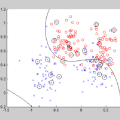Spike sorting, which classifies spiking events of different neurons from single electrode recordings, is an essential and widely used step in neural data processing and analysis. The recent development of brain-machine interfaces enables online control of external devices and closed-loop neuroprosthetics using single-unit activity, making online spike sorting desired. Most existing spike sorters work in an offline manner, i.e., sorting after data collection. However, offline spike sorters usually suffer from performance degradation in online tasks due to the instability of neural signals. In an online process, neuronal properties can change over time (such as waveform deformations), and new neurons can appear. Therefore, a static spike sorter requires periodic recalibration to maintain its performance. This study proposes a novel online spike sorter based on neuromorphic models (NeuSort), which can adaptively adjust itself to cope with changes in neural signals. NeuSort can robustly track individual neurons' activities against waveform deformations and automatically recognize new coming neurons in real-time. The adaptation ability of NeuSort is achieved by online parameter updates of the neuromorphic model, according to the plasticity learning rule inspired by biological neural systems. Experimental results on both synthetic and neural signal datasets demonstrate that NeuSort can classify spiking events automatically and cope with non-stationary situations in neural signals. NeuSort also provides ultra-low energy cost computation with neuromorphic chips.
翻译:脉冲分类是将单电极记录中不同神经元的尖峰事件进行分类的重要且广泛使用的神经数据处理和分析步骤。最近发展的脑机接口使用单元活动来实现对外部设备的在线控制和闭环神经假肢的使用,使得在线脉冲分类具有了必要性。大部分现有的脉冲分类器以离线方式工作,即在数据采集后分类。然而,离线脉冲分类器通常在在线任务中由于神经信号的不稳定性而出现性能下降。在在线过程中,神经元的特性可能会随时间而变化(如波形变形),并且新神经元可能会出现。因此,静态脉冲分类器需要定期重新校准以保持其性能。本研究提出了一种基于神经形态模型的新型在线脉冲分类器(NeuSort),它可以自适应地调整自己以应对神经信号的变化。NeuSort可以对波形变形进行有效跟踪,并能够自动识别新出现的神经元。NeuSort的适应能力是通过神经形态模型的在线参数更新实现的,这种更新根据受生物神经系统启发的可塑学习规则进行。在合成和神经信号数据集上的实验结果表明,NeuSort能够自动地分类尖峰事件,并应对神经信号的非稳态情况。NeuSort还利用神经形态芯片提供超低能耗运算。


